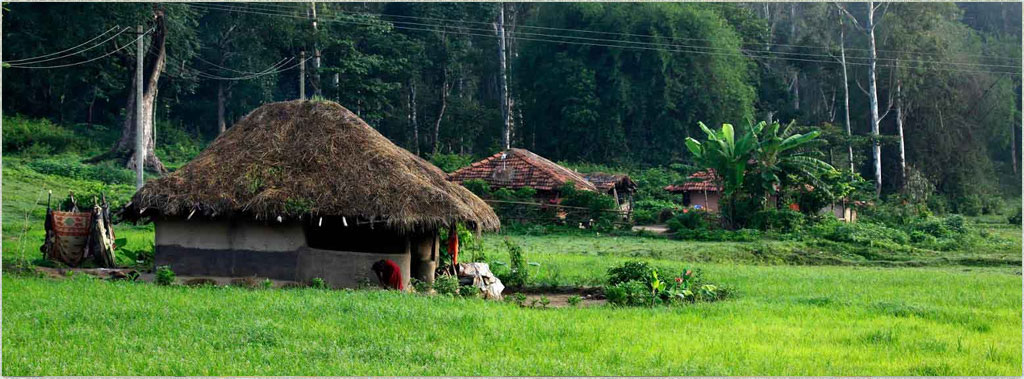They are the true sons of the soil.
They cleared the path to a drem land where they became slaves of sahibs and lords.
They still continue to believe and practice what is least common in most of us – respect and belief in nature.
They are the tribes of wayand, the true inhabitants of this magical place and recipients of a fascinating heritage. They can be prominently classified into Paniya, Adiya, Kattunayakan, Kurichiyan and Kuruma .
THE PANIYAS

The name ‘Paniyaan’ means ‘worker’ as they were supposed to have been the workers of non – tribes. Paniyas were once sold along with plantations by the landlords. They were also employed as professional coffee thieves by higher castes. They are believed to have been brought to Wayanad by the king of Malabar, and thereafter tilled the land as serfs.Normally the Paniya settlements (padis) may be a cluster of a few huts (pire or chala consisting of five to 15 families). Traditionally Paniyas were food-gatherers enjoying the freedom and self sufficiency of nomadic life in the interior forests. They used edible roots, leaves etc. They also used to eat small creatures like crabs by entrapping them. Although rice is their staple food, considerable quantities of wheat or ragi are consumed by the Paniyas. Tapioca, vegetables, animal flesh, fish, crabs and some varieties of roots and tubes are all included in their food items.They observe a number of festivals in different seasons. Some of these festivals are exclusively their own whereas some others are those which are regionally spread throughout the State.
ADIYAS
Adiyas are bascically agricultural workers. The Adiya, like the Paniya, is one of the slave sects in Kerala. In the nuclear Adiya tribal family the husband is the head of the house. Bride price is given to the parents of the bride by the groom. Divorce, widow marriage etc., are permitted. Polygamy is also practiced.
Even if their woman commits such offences they are allowed to undergo purificatory ceremony known as ‘Kalachu Veypu’ to join their community back. Gadhika is one such art from practiced among the Adiya community to drive away severe illnesses and diseases, which they believe is caused due to God’s dislike/anger towards them.
KATUNAYKARS
Once the kings of jungles, even to this day they rarely mix with other tribes and still follow their ancient traditions of black magic and sorcery. Completely dependent on forest and forest products for sustenance, they subsist on honey, roots and barks of plants and what small animals that they trap or fell with their primitive weapons like bows and arrows. The Kattunyakans were originally hunter gatherers, experts in fishing, bird trapping and foraging for forest produce such as honey and fruit. Kattunayakans typically live in clusters of small and very basic mud huts, plastered with charcoal and cow dung and thatched with paddy straw or grass. Music and dance are very important to the Kattunyakans, acting as the main source of knowledge on their environment, culture and respect for kin. A variety of musical instruments have been fashioned by the tribe; most resemble drums and flutes. Another important factor for the tribe is the medicinal system and its close association with the culture.
KURICHIYAS AND KURUMAS
 Also known as Malai Brahmins or Hill Brahmins, the Kurichiyas are the second largest adivasi community in Wayanad district. The community was named Kurichiya by the Kottayam Raja for the community’s expertise in archery. The name is derived from the phrase ‘kuri vechavan’, which means ‘he who took aim’.
Also known as Malai Brahmins or Hill Brahmins, the Kurichiyas are the second largest adivasi community in Wayanad district. The community was named Kurichiya by the Kottayam Raja for the community’s expertise in archery. The name is derived from the phrase ‘kuri vechavan’, which means ‘he who took aim’.
The Kurumas are a tribal community who are believed to have descended from the Vedars, the ancient rulers of this region. This community mainly dealt with forest products . Both the Kurichiya and Kuruma tribes are land-owning communities. They follow a matrilineal household system. They also share similarities in religious practices, rituals, festivals, language and food habits. Kurichiya refers to their settlements as tharavadu, muttam, etc. whereas Kuruma settlements were called kudi.
URAALI KURUMAS
Uraali Kurumas are an artisan tribe and their versatile skill in art and handicrafts are well known. They play flute and drum during festivals. One of their deities is ‘Bettu Chikkamma’ and a senior male member performs rituals before the deity and women are not allowed to participate in theses ceremonies. They believe that when one person dies, his soul becomes god if he is good and becomes devil if he is bad.Their main occupation is pottery, mat weaving etc. It is mostly the women who are involved in these tasks. They make baskets and mats of various types with reeds and bamboo.








